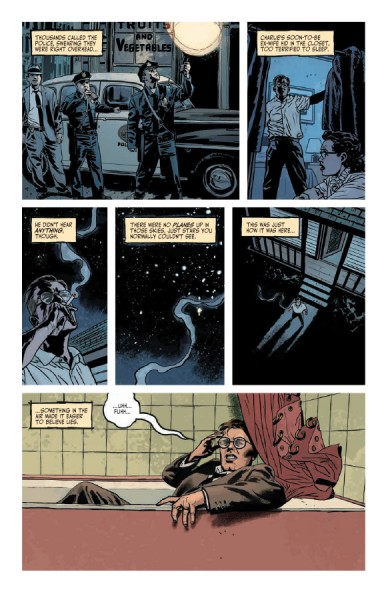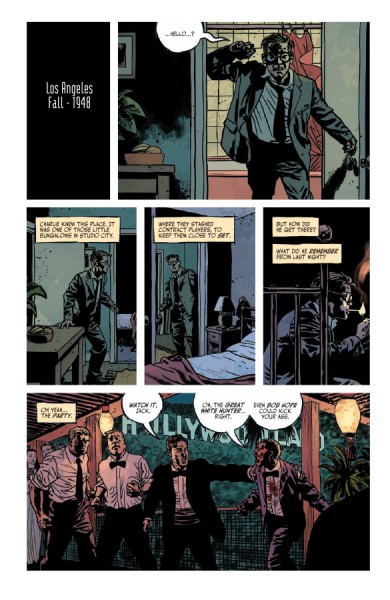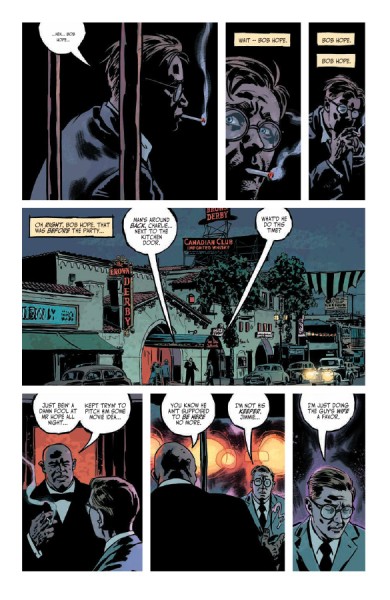The Fade Out #1 Review
"Sinner's City"
It wasn’t particularly surprising when it was announced that
The Fade Out, the new comic book project from Ed Brubaker and Sean Phillips, was going to be set in the grimy underbelly of 1940’s Hollywood. There has always been a cinematic quality to Brubaker’s work, and most of his collaborations with Phillips have had a pulp/noir feel. So it’s a short step to a story with that feel but without supernatural elements, just the murder and deceit.

The Fade Out #1 sets up with traditionally noir ingredients, but there is thoughtful attention paid to the characters and settings such that the issue feels interesting, if not totally new. The central character is Charlie Parrish, a screenwriter who has fallen in a seedy group of Hollywood industry partiers. He wakes up from a bender in a strange apartment and finds the dead body of rising actress Val Sommers. Panicked since he has no memory and no alibi, Charlie wipes the place clean, realizing that he’s making it probably making it impossible for the actual killer to be found.
Charlie begins to have a guilty conscience about his decision, especially when the studio’s head of security, a prejudiced bruiser named Phil Brodsky, tells the police it was a suicide. Charlie begins to wonder who know what, and feels himself pulled into the mystery, both to clear his name and perhaps Val’s as well. He seems to have only one confidant, Gil Mason, a writer who has been blacklisted since he was revealed to be a Communist. Publicly, Charlie and Gil are enemies but secretly friends.

The Fade Out throws a number of engaging twists in its first issue, though none are exactly jaw-dropping. The revelation that Gil and Charlie are actually friends, with the suggestion that Charlie is still a Communist even though he ratted out Gil, is a nice backstory subplot that adds depth. Secondary characters have some intriguing elements to them. Earl Rath is a Hollywood leading man and thought he doesn’t have any scenes in this issue, his debaucherous lifestyle is felt throughout
The Fade Out.
Sean Phillips is one of the artists with whom Brubaker has built a long history of collaborations (Steve Epting, Brubaker’s partner on
The Winter Soldier arc of
Captain America and currently
Velvet, is another). There has always been a grittiness and exactness in Phillips’ art, even when the stories occasionally veered into superheroics (
Incognito) or supernatural (
Fatale). So he seems perfectly situated in the old, nasty world of Hollywood. Colorist-extraordinaire Elizabeth Breitweiser lends her talents to
The Fade Out, and it’s the perfect mix of blacks, shadow, and muted color.

The film industry has a long history (especially in its early days) of bad behavior and resulting scandals. The Hays Production Code, which sanitized movies beginning in 1930, partially resulted from the fallout of the Fatty Arbuckle controversy.
The Fade Out is not the first tale to be set in this milieu (and might not even be the first comic). In fact, the premise of
The Fade Out is somewhat similar to the 1950 Nicholas Ray noir
In a Lonely Place. Although the issue at times feels too closely in the line of modern-day noirs like
Chinatown, there is enough promising character work done in issue #1 that
The Fade Out seems like it will be another strong series from Brubaker and Phillips.
Pros
- The story feels very authentic, with excellent details
- Art by Phillips and Breitweiser establish the dark feel expertly
- A number of characters seem potentially interesting
Cons
- The noir tropes feel somewhat familiar